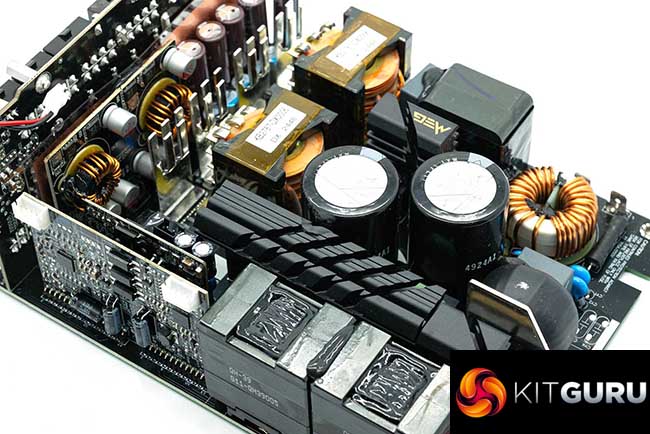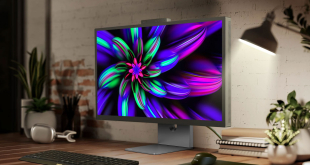This has certainly been a very interesting review for me and it has taken a longer time than normal as I needed to look into some of the Ai1600T design implementations. The MSI MEG Ai1600T is their flagship model and clearly they put a lot of time and effort into this design with the help of Channel Well Technologies expertise. The presentation, packaging and overall aesthetics of the unit are class leading.
Initial thoughts are impressive – unboxing this power supply is an experience in itself. The box weighs an absolute ton, and the packaging is at the highest level. You feel like you are opening something very special indeed. While the power supply is quite long at 190mm, it is in fact noticeably shorter than many other 1600 watt power supplies we have tested in recent years – which can often measure 210mm.
Ai1600T build quality is stellar, the materials used on the chassis are substantial and engineered to the highest levels. I can't say i am a huge fan of the gold accenting myself, but this is very much going to be down to personal choice at the end of the day. We know Gold colours are very popular in the ASIAN market but overall, I would consider the quality of build and appearance at the highest possible levels regardless of my abhorrence for gold PC components.
The Ai1600T performs adequately well, but the +3.3V rail is a little disappointing in certain situations and when hit hard with a lot of amps it reacts in a loose manner. Not enough to cause any real life concerns to be fair, but it could have been set up a little better in my opinion. I was quite surprised to see this was the case from a high end flagship model.
Technically, this is where things get interesting for me.
While the performance of the unit is quite good we have to factor in the pricing. This is what will help form a buying decision after all for most people. Well maybe not actually if you are still reading a review of a power supply which cost more than my Ducati V4R insurance for the year.
When I was told the pricing, my jaw literally hit the desk. MSI are placing a MSRP on this unit of £600. Checking the UK on 14th February, MSI pointed me to AWD IT – who have it listed for £609.99 (HERE). But it is only on pre order at AWD IT at time of publication so you can't actually buy it there yet.
EBuyer have it on their store right now for £637.65 (HERE) and CCL have it listed for £643.99 (HERE). When I spoke to MSI about this inflated pricing, they did tell me that prices will be dropping soon to around the £600 (MSRP) mark. I don't exactly know when this might happen, or if it even will – but that is what I was told. If you are reading this review months after it was published and the pricing is still around the £640 mark then we can both agree that MSI weren't entirely accurate.
My other issue with this power supply is the fact it is both using a Dual Ball Bearing fan and has no fan failure protection. While I have not had first hand experience with the A1250GS, A1000GS or A850GS, the literature I received from MSI claims they are all equipped with Fluid Dynamic Bearing fans. Fluid Dynamic bearing fans generally are a better option in a power supply than Ball Bearing fans, because in the space of a few years the lubricant in DBB fans can tend to dry up, which leads to higher noise levels and potential failure. It won't always be the case of course as environmental factors will also play a part, but as a general rule, you really do want a FDB fan rather than a DBB fan.
Think of it like this – as I mentioned earlier, the MSI Ai1600T has a substantial 12 year warranty, so if the DBB fan starts to make more audible noise in a few years as the lubricant dries up, I am pretty sure MSI would not replace the unit for you. After all it would still be classed as a fully operational product. Let's say this did happen and you opened the unit inside a 12 year warranty and replaced the fan yourself, you would have basically voided the remainder of your 12 year warranty.
I have asked MSI for a statement on this, but have not yet received a reply. I will update this page if I get a statement.
The lack of fan failure protection strikes me as unusual and after doing some research it would appear that one of the most skilled power supply experts on the planet – ARIS (Hwbusters) already asked the engineer who built this power supply about this problem and he was told that they would look into this for future designs (SOURCE: HWBUSTERS).
In closing, with the overall very good, but not ground breaking Ai1600T performance characteristics, and the relatively disappointing +3.3V rail performance, paired up with potential fan issues mentioned above it is hard to recommend this product without reservation. The kicker for me is the somewhat insane pricing in the UK of £640 ($805 dollars to our American friends reading this). I don't quite know the market MSI are targeting with this power supply, but to be honest, I would have preferred if they would have spent less time on the software development and RGB nonsense and focused a little more on some critical tuning of the unit which would have helped it score higher in our technical tests.
Pros:
- Class leading build quality.
- Very quiet operation.
- 12V Tight load regulation.
- Ripple suppression is pretty good.
- 12 Year Warranty.
- superb efficiency results.
- You might like RGB and software install.
Cons:
- long term double ball bearing fan concerns.
- 3.3V rail could be better.
- No fan Failure protection.
- ‘Ai' branding. No its not constantly adapting via algorithms, its a power supply.
- How much?
- You might hate RGB and software install.
Kitguru says: The Ai1600T is a good power supply that deserves consideration. With a high retail price of £640 in the UK and some concerns mentioned in the full review we can only offer it a reserved recommendation.
 KitGuru KitGuru.net – Tech News | Hardware News | Hardware Reviews | IOS | Mobile | Gaming | Graphics Cards
KitGuru KitGuru.net – Tech News | Hardware News | Hardware Reviews | IOS | Mobile | Gaming | Graphics Cards




